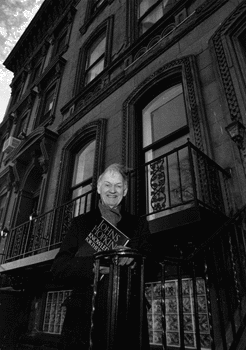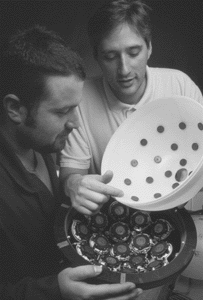
 125th anniversary: A walk through Hopkins
history
125th anniversary: A walk through Hopkins
history
Frank Shivers likens the beginnings of The Johns Hopkins
University to the tale of A Connecticut Yankee in King
Arthur's Court or, perhaps more accurately, Connecticut
Doctors in Lord Baltimore's City.
Prior to Hopkins' founding in 1876, the
Baltimore area was not devoid of colleges, medical schools
or doctors for that matter. So, when it was announced that
the new university and hospital proposed for the city would
be led by a group of New England-educated men, Shivers says,
Baltimoreans didn't exactly throw their arms open in a show
of hospitality.
"You've got to understand this was
post-Civil War, when many Southerners gravitated to
Baltimore because they could get jobs here and numerous
residents were sympathetic to the South," says Shivers,
author, historian and instructor at the School of
Professional Studies in Business and Education. "So here
were all these Southerners who were quite happy with the way
things were, and then in comes this new institution [with]
largely Yale alumni in leadership. They viewed it as a group
of Yankees coming to town."
Full story...
 Spherical motor allows ball-based 3-D
movement
Spherical motor allows ball-based 3-D
movement
Engineers at Johns Hopkins have invented a globe-shaped
motor that is capable of rotating in any direction. The
device, which uses electromagnets controlled by a computer,
could give robotic arms greater flexibility and precision
and might even allow the lowly computer mouse to guide the
hand of the computer user, instead of the reverse.
These advances could come about because
the new spherical motor permits a wide range of unhindered
mechanical motion. "A conventional motor turns on an axis,
moving in one direction," Gregory S. Chirikjian, an
associate professor in the Whiting School's Department of
Mechanical Engineering, explains. "What we've developed is a
new type of spherical motor. Basically, there's a ball
inside, and we can rotate it in any direction we want."
Full story...
| [ The Gazette | Search | About the Gazette | Send us Email ] |
The Gazette
 The Johns Hopkins University
The Johns Hopkins University Suite 100
 3003 N. Charles St.
3003 N. Charles St.
 Baltimore, MD 21218
Baltimore, MD 21218410-516-8514
 gazette@jhu.edu.
gazette@jhu.edu.
